#Africa Unchained
Explore tagged Tumblr posts
Text
Funky Bass in 21 songs
I’ve compiled another very subjective list with the 21 best songs with an awesome funky basslines.

Africa Is Home - Joe Mensah (Joe Mensah, 1975)
Born Black - The 4 Sensations With The Moonlighters Band (Born Black / Only Love Up Ahead (Don't Be Afraid), 1969)
Cold Water - Julius Brockington (Sophisticated Funk, 1972)
Come Out Smokin' - The Panic Buttons (Come Out Smokin' / Bad Karma, 1969)
Dolana Ay Dolana - Mustafa Özkent (Gençlik İle El Ele, 1973)
Esperar Prá Ver - Evinha (Cartão Postal, 1971)
Fonky Flute - James Rivers (Fonky Flute / Unchained Melody, 1969)
Funky Down Easy - Jerry McCain (Welfare Cadillac Blues / Funky Down Easy, 1970)
Funky Soul Train - Robert Parker (Funky Soul Train / Robert & W.Q's Train, 1967)
Give a Damn About Your Feller Man (2) - Benny Gordon & The Soul Brothers (Give a Damn About Your Feller Man (1) / Give A Damn About Your Feller Man (2), 1971)
Grave Yard Creep - James Duhon (Grave Yard Creep - James Duhon / Color Me Soul - Talmadge Armstrong, 1974)
I Wish (A Way Out Of No Way) - Frances Moore & the East St. Louis Gospelettes (A Way Out Of No Way, 1979)
The Jed Clampett - The Sister And Brothers (The Jed Clampett - Part 1 / The Jed Clampett - Part 2, 1970)
Lay-Out - R. Conrado, A. Scuderi, P. Montanari (Bass Modulations, 1973)
Lets Be Free - Aktion (Celebration, 1977)
Marabuena - Charly Antolini's Power Dozen (Atomic Drums, 1972)
Naku Penda - Mfalme (Naku Penda, 1976)
Soul Chills (Vocal) (Part I) - Dede Soul And The Spidells (Soul Chills (Vocal) (Part I) /Soul Chills (Instrumental) (Part II), 1967)
Studio In Chiave Di Basso - I Marc 4 (I Marc 4, 1971)
That's How I Feel - Jiro Inagaki & His Soul Media (In The Groove, 1973)
You Stepped Into My Life - Melba Moore (This Is It, 1976)
More Funky Bass
30 Funky Basslines
Best Funky Bass Lines : 25 tracks
Bass in Gospel: Bass for Believers
More Funky Basslines
Funky Basslines in Soul Music, part 5
Top 10 basslines in Soul and Funk Music, part 4
Top 10 basslines in Soul and Funk Music, part 3
Top 10 basslines in Soul and Funk Music, part 2
Top 10 basslines in Soul and Funk Music, part 1
21 notes
·
View notes
Note
Hey I was trying to find what ancestry which it comes to tribes most African Americans have and your mutual (I think helped) https://www.tumblr.com/theconstitutionisgayculture/693392069742542849
And I found out the Yoruba are the majority of North American African slaves ancestry. And they also the biggest tribe in Nigeria
Is it wrong I went “OOOOOOOOOOOOH” as I saw one Nigerian woman that look just like my late godmother and now I know why.
Just wondering despite the dna ancestry this isn’t taught to Africa Americans, especially it would help end the whole pan Africa thing
…Though Nigerians would have to deal with annoying ass black activists Americans, they probably going struggle some benin with some Dahomey ancestry for that.
But I found out the Mandinka tribe make up most of southern United state slavery ancestry. I mean like in New Orleans and even in Brazil. And tbh I know something was different about Louisianan blacks
Well at least we know why New Orleans Creoles are raging capitalists
It the Mansa Musa blood flowing in them.
You know with the whole new Princess and the frog theme ride. Disney made up new lore and they confirm Tiana open up her own company that still exist today. I kinda want to write a story where her descendants does a dna test and found out they have Mandinka ancestry hence their great great grandmother whole business idea…obviously it other reasons but still funny.
Not mutuals but @theconstitutionisgayculture are in the same circle
As for which group, it would be whichever ones were closest to the Dahomey and whoever else was picking people up and selling them since there were lots of them going on.

10 or so million people need several suppliers, even if only like 3-400,000 of them came to the US (people seem to forget that like >90% went to SA, not that that makes things better but spread the blame please) Mexico started late and just enslaved it's indigenous population, in what would be called a genocide today I think.

Dahomey is right there in the Benin spot where we got 16% it looks like SE Africa is news to me.
Not sure if the various DNA tests can pinpoint a particular group, maybe to the level of "Bantu" which is a incredibly broad spread of people so hopefully better than that.
You said Yourba
The Yoruba people are a West African ethnic group who mainly inhabit parts of Nigeria, Benin, and Togo.
That would fit for Dahomey at least, cuz Benin.
Here's the Mandinka, which that oddly enough jives with Django Unchained
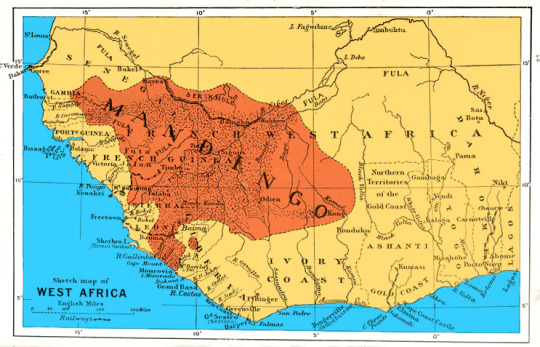
Seeing a lot of Fula in there, that was the group that did the Fula jihads so forcibly converted to Islam, shipped to the Americas, or possibly castrated but absolutely sold to Arabic groups were their choices then.
Interesting.
This is mostly me just putting up what I'm seeing so far if you're confused it's ok so am I.
Well at least we know why New Orleans Creoles are raging capitalists It the Mansa Musa blood flowing in them.
New Orleans is a odd cross section of the US population, even way back when.
It was still racist AF, but the French connection created some odd population pockets,
Louis Armstrong with his Lithuanian Jewish neighbors who well.
In his memoir, Louis Armstrong + the Jewish Family in New Orleans, La., the Year of 1907, he described his discovery that this family was also subject to discrimination by "other white folks" who felt that they were better than Jews: "I was only seven years old but I could easily see the ungodly treatment that the white folks were handing the poor Jewish family whom I worked for."
Guy wore a Star of David always, in their honor they made a big difference for him, but I'm stopping there or I'll go into tangent land.
place is just strange, and the locals wouldn't have it any other way
You know with the whole new Princess and the frog theme ride. Disney made up new lore and they confirm Tiana open up her own company that still exist today. I kinda want to write a story where her descendants does a dna test and found out they have Mandinka ancestry hence their great great grandmother whole business idea…obviously it other reasons but still funny.
That could be fun, if you do it be sure and send it this way so I can read it, I may wind up totally confused but that's ok.
7 notes
·
View notes
Text
STARKS DAEMON Unleashes Debut EP "Unchain" + Video for 'Too Deep'
Starks Daemon, one of Africa’s leading figures in the rock/metal scene, has just released his debut EP Unchain along with a gripping video for the track Too Deep. The EP, available online since March 3, 2024, quickly topped the African Metal charts, holding the number one spot for four weeks. Hailing from Botswana, Starks Daemon has been the frontman of international metal band Wrust for over 23…

View On WordPress
3 notes
·
View notes
Text
⚠️Trigger Warning: This poem contains themes of trauma, rape culture, and oppression, which may be distressing for some readers. Please take care of yourself as you engage with this content.
Abongile's Clarion Call to Rise: (Nakhane)
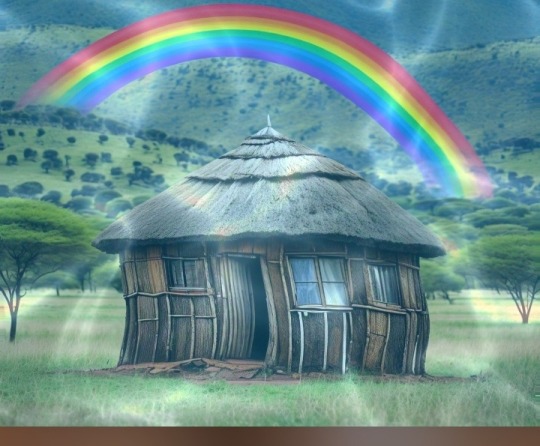
In South Africa's wounded soul,
Where rainbow dreams are tainted by a painful role,
A young heart beats, a spirit whole,
Abongile's voice echoes, a clarion call to unfold.
A pen flew
Ringing a temple bell
One hand raises, voices swell
The power of their lips in black and white.
A loud voice echoes Nakhane! (Build one another)
Against the darkness that enthralls,
The stigma that shames, the hate that appalls,
Communities impacted with HIV and AIDS,
Albinism and Beyond, Homosexuality, single mothers, and dysfunctional families, anew.
Nakhane!
Lift my struggles, wipe my tears
Sit at my table, fix my crown
For my smile is a mask of pain (Build one another)
Rape culture's scars, a wound that won't heal
A nation's silence
When the ice is broken!
But still we rise, with every breath
A drumbeat resounds, a rhythm of defiance and death
Nakhane! (Build one another)
With every word, a spark ignites
A fire of vibrant hope, A shameless rainbow
A fire of hope, a burning light
Melting chains, Breaking the mold, unleashing the power of a people bold
Nakhane! (Build one another)
In this maelstrom of emotions, we're swept away
By the torrent of truth, the power of Nakhane's sway
A call to action, a beacon of light
Guiding us through the Valleys of Injustice.
A lion roars, his voice takes flight
A fiery passion, a burning light
Illuminating the path through the darkest night
Leading us forward to a brighter light
Nakhane!!! (Build me too)
With every word, a spark ignites
A fire of vibrant hope, A shameless rainbow.
A fire of hope, a burning light
Melting chains, breaking the mold, unleashing the power of a people bold
We rise, unbroken, unshaken
Our voices loud, our hearts unchained
We shatter the silence, we shatter the pain
We rise, and our freedom reigns
Nakhane!
Let's connect the rainbow pattern together.
#rapeculture#queen of tears#queer#queer nsft#gay art#star wars#rainbow#lgbt pride#gay pride#trans pride#no to hate#aids crisis#my poerty#poertycommunity#poetry#lgbtq#welcome home#asexual#ryan gosling#michael cera#artists on tumblr#yellowjackets#easter#margot robbie#wally darling#pooltoys#powerpuff girls#art
3 notes
·
View notes
Text
user name song game
Tagged by @spitzobsessed , @space-unicorn-dot, and @thebreadtree (2 weeks! Turn around time is improving!!)
Rules are simple: pick a song for each letter of your URL and tag that many people. (oh yikes)
No pressure Tagging: -- @starlightcleric @vexa-legacy @inqorporeal @alexsrandomramblings annnnd anyone else who wants to do this and hasn't not done so already.
S -- Slide by the Goo Goo Dolls
U -- Unchained Melody by the Righteous Brothrs
L -- Lady D'Arbanville by Cat Stevens/Yusuf Islam
L -- Lady's Got Potential from the Evita Soundtrack
U -- Uninvited by Alanis Morissette
S -- Set Me Free by Velvet Revolver
T -- Temptation by the Tea Party
A -- Africa by Toto (or by Chaos Divine)
N -- No Leaf Clover by Metallica
G -- Going Up the Country by Canned Heat
I -- I Got You Babe by Sonny and Cher
N -- Nick Rivers Medley from Top Secret
3 notes
·
View notes
Photo
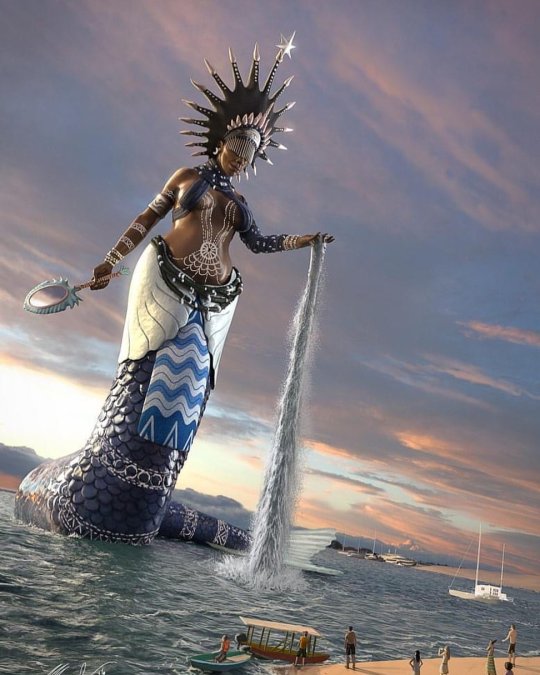
Respect! Herstory: Celebrating the Feminine Journey Series: 31 Goddesses Goddess #3: Yemaya Origin: West Africa & The Caribbean (Yoruba) In the African diaspora, Yemaya (Yemoja) is known as “Mami Watta” (Mother of the Water). She is the Nurturing Mother Goddess of living waters. While mostly known for being even-tempered, when angered Yemaya can be violent and relentless like a storm in the ocean. Her anger is righteous: She fiercely protects what she loves and restores balance to instability. She is often depicted as a mermaid, dressed in blue and white, with cowrie shells representing her vast wealth. Her strong and protective energy can be found virtually everywhere, but especially near oceans and lakes. Her Legacy: The power of surrendering to Divine flow, destruction to clear the way for new life, Divine protection of mothers and children, fertility, self-love, healing emotional wounds and trauma. May we connect to the Divine Feminine within us and remember who we are. -compiled by Molesey Crawford, The Queen Code, Inc Artist: Mikael Quites (www.mikaelquites.com) Works Consulted: “Legendary Ladies” by Ann Shen #womenshistorymonth #womensherstorymonth #herstory #queenascension #trusttheprocess #purpose #royalpath #royalpathmap #divinefeminine #goddessrebirth #ascension #5DQueen #ancientwisdom #oldsoul #unchained #queencode #thequeencode #therealqueencode (at Times Square, New York City) https://www.instagram.com/p/CpVHrIrs2XG/?igshid=NGJjMDIxMWI=
#3#womenshistorymonth#womensherstorymonth#herstory#queenascension#trusttheprocess#purpose#royalpath#royalpathmap#divinefeminine#goddessrebirth#ascension#5dqueen#ancientwisdom#oldsoul#unchained#queencode#thequeencode#therealqueencode
6 notes
·
View notes
Text
The Universal Appeal of Music Across Generations
Music is a timeless bridge between generations, connecting the young and old through melodies, lyrics, and rhythms. It transcends age, culture, and language, becoming a universal language that binds people together. Whether it’s a classic rock anthem passed down from parents or a contemporary hit shared between friends, music serves as a common thread in our collective human experience.
In this article, we explore how music unites generations, with examples like the cultural legacy of Sidhu Moose Wala, the enduring charm of soft songs, and the unifying power of radio hits.
Sidhu Moose Wala: A Voice for All Ages
The music of Sidhu Moose Wala resonates across generations. His ability to blend traditional Punjabi music with modern beats makes his work accessible to both older listeners who value cultural roots and younger audiences who appreciate contemporary sounds. Tracks like “Dollar” and “Warning Shots” exemplify this balance, appealing to a broad demographic.
Sidhu Moose Wala’s lyrics often touch on universal themes such as love, resilience, and cultural pride. These topics transcend age, making his music relatable to people from diverse walks of life. By preserving Punjabi heritage while embracing modernity, Moose Wala has become a symbol of unity, showing how music can connect generations.
Soft Songs: A Timeless Comfort
Soft songs have an enduring appeal that cuts across generational lines. The soothing melodies and heartfelt lyrics of soft songs create a sense of calm and introspection that resonates with listeners of all ages. Whether it’s a lullaby sung to a child or a peaceful track played during a quiet evening, soft songs provide a universal sense of comfort.
Classics like Simon & Garfunkel’s “Bridge Over Troubled Water” remain as poignant today as they were decades ago. Meanwhile, contemporary artists like Ed Sheeran continue the tradition with tracks such as “Perfect,” which appeal to both older audiences and younger listeners.
Soft songs prove that the desire for peace and reflection is a constant across generations, making them a timeless genre.
Kiss Songs: Love Knows No Age
Romantic music is a genre that never goes out of style, and kiss songs are a perfect example. These tracks, celebrating love and intimacy, resonate with listeners of all ages. From young couples discovering their first love to older partners rekindling their romance, kiss songs are a shared musical experience.
Iconic tracks like “Unchained Melody” by The Righteous Brothers have become timeless anthems of love, cherished by multiple generations. At the same time, newer songs like Bruno Mars’s “Just the Way You Are” bring fresh perspectives to the genre.
Kiss songs remind us that love is a universal emotion, and music’s ability to capture this feeling ensures its relevance across generations.
Radio Songs: Soundtracks of Shared Memories
The impact of radio songs on connecting generations cannot be overstated. These tracks, played repeatedly on airwaves, become shared cultural touchstones. Parents introduce their favorite radio hits to their children, who, in turn, carry them forward as part of their musical heritage.
Songs like “Bohemian Rhapsody” by Queen or Michael Jackson’s “Thriller” are timeless examples of radio songs that have transcended their original eras. These tracks bring families together at gatherings, road trips, and celebrations, creating lasting memories.
Radio songs are a testament to music’s ability to bridge the past and the present, ensuring that iconic tunes continue to be celebrated by new generations.
Songs with T: A Fun Exploration Across Eras
Exploring unique themes like songs with T can uncover hidden gems that span decades. These tracks highlight the diversity of music across genres and generations, offering something for everyone.
For instance, Toto’s “Africa” is a classic hit that continues to enjoy popularity among younger audiences, thanks to its resurgence on social media. Similarly, Taylor Swift’s “Teardrops on My Guitar” appeals to a younger crowd while still capturing universal themes that resonate with older listeners.
Songs with T showcase the creativity and evolution of music, demonstrating how a single concept can unite listeners of all ages.
Music as a Timeless Connector
Music’s ability to connect generations lies in its universal themes and emotional resonance. Whether it’s the cultural pride found in Sidhu Moose Wala’s tracks, the peaceful reflection offered by soft songs, or the romantic allure of kiss songs, music speaks to shared human experiences. Radio songs act as cultural artifacts, bridging gaps between eras, while playful themes like songs with T remind us of music’s boundless creativity.
By sharing and celebrating music across generations, we strengthen our connections to each other and our cultural heritage.
Conclusion
The universal appeal of music ensures its place as a timeless bridge between generations. Sidhu Moose Wala’s artistry preserves cultural roots while engaging younger audiences, soft songs provide enduring comfort, and kiss songs celebrate love that knows no age. Radio songs create shared memories, and themes like songs with T showcase music’s creativity and inclusivity.
How Has Music Brought Your Family Together?
Do you share playlists with your family or have favorite songs passed down through generations? Share your stories and tracks in the comments below—we’d love to hear how music connects your world!
0 notes
Text
Starks Daemon Unleashes Debut EP 'Unchain' and Video for 'Too Deep'
Starks Daemon, one of Africa's leading figures in the rock/metal scene, has just released his debut EP Unchain along with a gripping video for the track Too Deep. The EP, available online since March 3, 2024, quickly topped the African Metal charts, holding the number one spot for four weeks.
Starks Daemon, one of Africa’s leading figures in the rock/metal scene, has just released his debut EP Unchain along with a gripping video for the track Too Deep. The EP, available online since March 3, 2024, quickly topped the African Metal charts, holding the number one spot for four weeks. Hailing from Botswana, Starks Daemon has been the frontman of international metal band Wrust for over 23…

View On WordPress
0 notes
Audio
(Motif-Radio) Reggae Pon Top # 18 2024, track listing:
SINGLES: UNCHAINED VERSION KUMAR & CAPLETON- WORK DELTON SCREECHIE- JAH MYSTIC TONY TUFF- COME FE MASH IT TUFF LIKE IRON & EVIE- ALL TIME HIGH JASHII & LILA IKE- BLESSINGS BLACK ROOTS- FREE AFRICA DAWEH CONGO- BIG BAD SOUND JC LODGE- LOVE IS BLIND SINGER J- FIRE BURNING KABAKA PYRAMID- MAKE THINGS WORK PRODUCER AJAL & EESAH- REAL GANJA FARMER
RIDDIMS: HIGH PLACE RIDDIM GODSPEED RIDDIM PURE THOUGHTS RIDDIM
DANCEHALL: PABLO YG & BOB KLEAN- WAR GYPTIAN & TROUBLEMEKKA- ALL OF ME ARMANII- FIESTA STLE MAGIK & GINJAH- IBADIJU DEJA VU RIDDIM FAT BEAST RIDDIM BOUNTY KILLER- WINE NIGY BOY- JUDGEMENT
ROOTS/ONE DROP/LOVERS ROCK: TONY TUFF- WATER PUMPIE TONY TUFF- GIRL I HAVE TO GET YOU TONY TUFF- DUBPLATE BAYONICS- MR. POLICEMAN DELTON SCREECHIE- YOU ARE THE BEST THING MADI SIMMONS- HOW DOES IT FEEL BLACK ROOTS- ROOTS MYKAL ROSE, SUBATOMIC SOUND SYSYEM, HOLLIE COOK- GET HIGH RACHAAD AMARJII FEAT. JAH LIGHTNING- CALL ON H.I.M. SADIKI- CORNERSTONE ANTHONY QUE- SEE DEM ROGER ROBIN- ROCKY ROAD RAS DEGUS- KEMIST SIDE EYES DENNIS BROWN- IF I HAD THE WORLD
1 note
·
View note
Text
Women-led organizations & partnerships that you can donate to to help girls:
FORWARD (Foundation of Women's Health Research and Development) - An organization working to end violence against women and girls, FGM, and child marriage/forced marriage.
AWRA (African Women’s Rights Advocates) - A movement committed to creating calls to action on policies affecting African women and girls and creating sustainable change so that African women and girls can thrive. AWRA aims to liberate African women and girls by combating FGM, child marriage/forced marriage, violence against women and girls, period stigma, period poverty, and more.
Girls Not Brides - A global partnership of more than 1,500 organizations from over 100 countries committed to ending child marriage and enabling girls to fulfill their potential.
Unchained At Last - An organization that provides free legal and social services to help women and girls in the US escape forced and arranged marriages. Unchained also pushes for legal change; the organization started and now leads a growing national movement to eliminate child marriage in every US state and at the federal level.
FAWE (Forum for African Women Educationalists) - An organization founded by five female ministers of education that promotes girls’ and women’s education in sub-Saharan Africa.
SafeHands - An organization dedicated to providing women and girls with support and education on sexual and reproductive health, reproductive rights, and FGM in order to help them make informed decisions over their bodies and lives.
Malala Fund - An organization that advocates — at local, national, and international levels — for resources and policy changes needed to give all girls a secondary education.
The Dahlia Project - An organization that provides support and counseling services to survivors of female genital mutilation.
If you happen to know of any other women-led organizations and movements that belong on this list, feel free to add on!
1K notes
·
View notes
Note
15 and 24 for the music asks! ☺️
15. three songs you want to dance with your love to
Slow Dancing by Aly & AJ, The Wonder of You (Villagers cover), Twist of Fate by Olivia Newton John
24. three favourite old songs
Africa by Toto (this ones for the Stancies), Unchained Melody by The Righteous Brothers, La Mer by Charles Trenet
Thanks for playing <3
3 notes
·
View notes
Text
Kenyan artist Maia Von Lekow, a songwriter and musician, released her sophomore album “Maia & The Big Sky” in 2018 on both digital and vinyl records. No Kenyan musician has released an album on vinyl since the late 1980s. Since music listeners have pivoted toward digital streaming platforms, Maia is one of the few artists who views vinyl records as more than just a novelty.
In this part two of our three-part series on vinyl in Kenya, we highlight women like Maia who are catalyzing an ongoing global vinyl revival.Read Part one here.
First Kenyan vinyl in 33 years
Kenya’s vinyl record history dates back to the late 1950s. However, it was not until the mid-1960s when, prompted by a vibrant interest in local recordings, local shops such as the E. A Records pushed Kenya into the record-pressing business.
From the 1960s to the 1980s, Nairobi was the heart of East and Central Africa’s music production and vinyl pressing industries. Bands from as far as the DRC Congo and Zaire traveled to Nairobi to record and produce their music.
It has been 33 years since the last vinyl pressing plant shut down in Kenya. In the early 1990s, the global music recording business had just undergone yet another musical format evolution. Users’ attention shifted from vinyl to cassette tapes, and then to CDs. CDs became the de facto release format for decades until streaming came along in the early 2000s.
Another Kenyan artist Blinky Bill whose album, “Everyone’s��Just Winging It And Other Fly Tales,” was also released on both digital and vinyl in 2018. These artists’ choice of musical formats is intended to honor their African music heritage and pay homage to the many African musical giants whose music was released on vinyl between the 1960s and the late 1980s.
Maia is the daughter of music legend Sal Davis. Davis’s hits released in the 1960s include “Makini,” “The moon was Yellow,” and his cover version “Unchain my heart” by Ray Charles were all released on the 45 RPM 7-inch “extended-play single” (EP) format.
What inspired her to release her latest album on vinyl? “It was the nostalgia!” she said.
She told Global Voices during an email interview.
We didn't have a record player in our house when I was growing up, however, our neighbour did. We used to go there and put the records on and just the idea of removing it from the sleeve, putting it onto the player and dropping the pin, changing to the B side. There is something very special about the whole process of playing vinyl. I wanted to replicate this in the printing of my music. Being one of the first few Kenyan artists to print on vinyl. That for me was a space finding idea.
She describes the process of getting her vinyl pressed as a tricky, difficult, and expensive process. There are no pressing plants in Kenya. However, last year she performed a few shows in Australia and was able to print from there. But they still had to figure out the logistics of bringing the records back to Kenya for distribution and sale.
“Shipping was expensive, so then we had to do it in manageable quantities that could fit in a suitcase. It’s not feasible if you are a big selling artist.”
In the end, she admits that it was all worth it.
What is great is that there’s a real need. We sold most of my album on vinyl in Kenya. Our main outlet was Jimmy Rugami’s shop. The fact we included a link on the vinyl covers for one to get the digital version meant that buyers were able to have the best of both worlds. It has been really wonderful seeing so much interest in my music as well as in both old school and contemporary. Am glad that we did it.
When discussing how she was influenced by her dad’s music, she recalled his vinyl releases and a long-standing appreciation for the format.
For me, it was also about how we bridge that gap between the older and younger generation of musicians and listeners. vinyls have endured the test of time.
Deejaying in male-dominated spaces

While the Kenyan Deejaying industry is male-dominated, a few female Deejays have managed to play and own their space.
Jumoke Adeyanju, aka Mokeyanju, is a Nigerian-born woman DJ who has made Kenya her second home. A passionate vinyl selector and DJ, she is a multifaceted artist, poet, and curator with a deep-rooted affection for the East African and Caribbean cultures and sounds. Mokeyanju was one of the DJs who played a set at Rugami’s record store to mark this year’s world record store day.
You are unlikely to catch Mokeyanju in the clubs rocking a crowd. Instead, she works with various organizations curating online shows, such as her recent Sauti ya AOKO (the sound of Akoko), which was a live poetry and vinyl session she did for the organization Refugee Worldwide.
She, like her fellow Kenyan vinyl DJs, maintains an active presence onsocial media. A globetrotter who spends most of her time shuttling between Europe, Nigeria, and Kenya, her fans can easily follow her gigs and listen to her latest mixes online.
Kenya is experiencing a vinyl revival. Heralded, in large part by the growing interest in East African music both at home and globally, there is a resurgence of interest, especially among the younger generation of music lovers eager to reconnect with their vinyl musical heritage.
1 note
·
View note
Note
If i could nat turner racist as a ghost... I'd welcome death honestly.
Bro. I'm half Black half Cherokee. I'm taking revenge for BOFF SIDES!
I'm taking out politicians first. First the Queen gonna get it for her crusty ass, tyrant ass ancestors that started all this colonizer shit when they sent them rinky-dinky ass boats to over here and to Africa and I'm gunning for the old present alive first then the rest (Obama gonna have to go to the streets) and Bitch McConnell rotten crawfish looking ass
I am Django unchained whipping, I'm waking mfs and they entire bloodlines up OUTTA THE SLEEP wit it.
AND IF YOU THINK YOU CAN SALT RING MY ASS, I'LL SEASON YOU WITH IT!


21 notes
·
View notes
Photo

Secret history: the warrior women who fought their enslavers | Slavery | The Guardian
... “If you’re a black child, you learn about slavery but you don’t learn about slave resistance or slave revolt in America,” Rebecca Hall says.
“But if you’re taught the history of resistance, that our people fought every step of the way, that is a recovery that is crucial to our pride in our humanity and our strength and struggle. So the issue of slave resistance is something I think everyone should know about.”
She drew a blank though. Every book about slave revolts said more or less the same thing, that men led the resistance while enslaved women took a back seat. “I was like, what’s going on, I don’t believe it’s true,” says Hall.
So she started the painstaking process of sifting through the captain’s logs of slave ships, old court records in London and New York, letters between colonial governors and the British monarchy, newspaper cuttings, even forensic examinations from the bones of enslaved women uncovered in Manhattan.
Much of it made for difficult reading – human beings described time and time again in documents and insurance books as “cargo” with footnotes describing “woman slave number one and woman slave number two”. “Seeing them writing about my people as objects – It was horrific,” she says.
She learned that Lloyd’s of London was at the centre of the insurance market at the time, providing cover for slave ships, a “shameful” legacy for which it apologised last year. “They were insuring against the insurrection of cargo – I think that completely sums it up. How can cargo insurrect?” asks Hall.
As hard as this was to digest, it started to open new windows into the past – and as Hall pieced the information together she began to find women warriors everywhere, not only resisting their enslavers but planning and leading slave revolts.
In one example, Hall discovered that four women were involved in the 1712 revolt in New York, an uprising by enslaved Africans who killed nine of their captors before being, in some cases, burned at the stake. One pregnant woman was kept alive until she gave birth and then put to death (the execution was delayed, says the report, because the baby was “someone’s property”). Until now, it was assumed only men took part in this revolt. ...
... Hall discovered that out of the 35,000 slave ship voyages documented, there were revolts in a tenth of them. And when she analysed the difference between ships that had revolts and those that didn’t, she discovered there were more women on the ships with uprisings.
��Historians literally say that this must be a fluke as we know that women didn’t revolt,” she says.
But closer examination of slave ship records showed key new facts.
There were procedures for running these ships, Hall explains – and right at the top was the instruction to keep everyone below deck and chained while you were on the coast of Africa.
“But once you got into the Atlantic, you unchained the women and children and brought them on deck,” she says.
That’s when Hall began to find stories of women accessing the weapons chests and finding ways to unchain the men below. “They used their mobility and access,” she says.
The conservative estimate is that 16 million Africans were brought to the Americas as enslaved people and while we don’t know exactly how many were women, we do know there were huge numbers, Hall says.
She hopes, now, that people will begin to realise how important these women were to resistance. ...
#Rebecca Hall#African Americans#Women#Women's Issues#racism#xenophobia#slavery#evil#sexism#misogyny#inequality#WTF men?!#Graphic Novels#history
4 notes
·
View notes
Text
The Academy to Honor Danny Glover, Samuel L. Jackson, Elaine May and Liv Ullmann with OSCARS® at 2022 Governors Awards

Steven McQueen (left) and Danny Glover at the 6th Annual Governors. Photo credit A.M.P.A.S.

Samuel L. Jackson as Jules, the PULP FICTION actor received an Oscar nomination for Supporting Actor. Photo credit A.M.P.A.S.
***
The Academy of Motion Picture Arts and Sciences has announced that its Board of Governors voted to present Honorary Awards to Samuel L. Jackson, Elaine May and Liv Ullmann, and the Jean Hersholt Humanitarian Award to Danny Glover. The four Oscar® statuettes will be presented at the Academy’s 12th Governors Awards on Saturday, January 15, 2022, in Los Angeles.
“We are thrilled to present this year’s Governors Awards to four honorees who have had a profound impact on both film and society,” said Academy President David Rubin. “Sam Jackson is a cultural icon whose dynamic work has resonated across genres and generations and audiences worldwide; while Elaine May’s bold, uncompromising approach to filmmaking, as a writer, director and actress, reverberates as loudly as ever with movie lovers. Liv Ullmann’s bravery and emotional transparency has gifted audiences with deeply affecting screen portrayals, and Danny Glover’s decades-long advocacy for justice and human rights reflects his dedication to recognizing our shared humanity on and off the screen.”
Glover first caught the attention of movie audiences in The Color Purpleand went on to star opposite Mel Gibson in the Lethal Weaponseries. He has also appeared in To Sleep with Anger, The Royal Tenenbaums, Dreamgirls, Beyond the Lights and Sorry to Bother You. A lifelong community activist, his efforts for worldwide justice have inspired others to follow his leadership. He has been a particularly strong advocate for economic justice and access to health care and education in the United States and Africa. He has served as a Goodwill Ambassador for the United Nations Development Program and is currently a UNICEF Goodwill Ambassador.
Jackson has brought an indelible presence to his roles in more than 100 films ranging from independents to blockbusters. He earned an Oscar nomination for his supporting performance in “Pulp Fiction” (1994). He has starred in such films as “Spider-Man: Far from Home,” “Shaft,” “The Hateful Eight,” “Chi-Raq,” “Django Unchained,” “Black Snake Moan,” “Unbreakable,” “Jackie Brown,” “Eve’s Bayou,” “The Long Kiss Goodnight,” “A Time to Kill,” “The Great White Hype,” “Die Hard with a Vengeance,” “True Romance,” “Jurassic Park,” “Menace II Society,” “Jungle Fever,” “Mo’ Better Blues” and “Do the Right Thing,” as well as entries in the “Star Wars,” “Avengers,” “Iron Man” and “Incredibles” series.
May made her mark as a writer-director with “A New Leaf,” in which she also starred, “Mikey and Nicky” and “Ishtar,” and also directed “The Heartbreak Kid.” Her screenwriting credits include “The Birdcage” and she received Oscar nominations for the adapted screenplays for “Heaven Can Wait” (1978) and “Primary Colors” (1998). In the early 1960s, May achieved great success partnering with Mike Nichols, whom she met in an improvisational theater group, as a comedy team on stage and television.
Ullmann began her career as a stage actress in her native Norway. She came to the attention of international audiences in “Persona,” the first film she made with the Swedish director Ingmar Bergman. Their notable collaboration went on to include “The Passion of Anna,” “Cries and Whispers” and “Autumn Sonata.” Ullmann received Oscar nominations for Best Actress for “The Emigrants” (1971) and “Face to Face” (1976). She made her directorial debut in 1992 with “Sofie” and later directed “Faithless,” from a script by Bergman. Ullmann continued to work in theater for most of her career, making her New York stage debut in 1975 as Nora in “A Doll’s House.”
The Honorary Award, an Oscar statuette, is given “to honor extraordinary distinction in lifetime achievement, exceptional contributions to the state of motion picture arts and sciences, or for outstanding service to the Academy.” The Jean Hersholt Humanitarian Award, also an Oscar statuette, is given “to an individual in the motion picture arts and sciences whose humanitarian efforts have brought credit to the industry.”
# # #
#Film#The Academy#Oscars#Oscar Awards#OscarAwards#OscarAwards2022#academy of motion picture arts and sciences#The Jean Hersholt Humanitarian Award#Oscar statuette#Samuel L. Jackson#mikey and nicky#Liv Ullmann#Danny Glover#Red Carpet View#RCV#Naomi J Richard#naomijrichard#Naomi Richard#Academy’s 12th Governors Awards#12th Governors Awards
5 notes
·
View notes
Text
Hollywood’s Changing Depiction of Slavery
I am generally not that comfortable with discussing this kind of thing, especially the attachment it has to cinema, because it is a reminder that many of the people that created the art I love might not be the kind of person I would actually want to meet. In fact, the depiction of slavery in film over the last century can give you an idea of how the American population thought of slaves and the business of slavery in general. I am going to try and approach this objectively, not because I don’t want to offend (if you are offended by my personal abhorrence of slavery in any form than you can go someplace else for your movie commentary), but simply because I am a middle-aged white male who has never encountered slavery in person and everything I know is second hand. I have seen guest lectures that involved people who walked with MLK Jr in Alabama, but I know very little about black oppression and outright slavery in America beyond history books. So, to keep this educational and not slip into personal bias, I will describe what I have seen in some example films over the last century. You are more than welcome to view the films for yourself, however:
SOME SPOILERS FOR THE MOVIES ON THIS LIST!!! I STRONGLY RECOMMEND WATCHING ANY OF THESE FILMS FOR YOURSELF!!
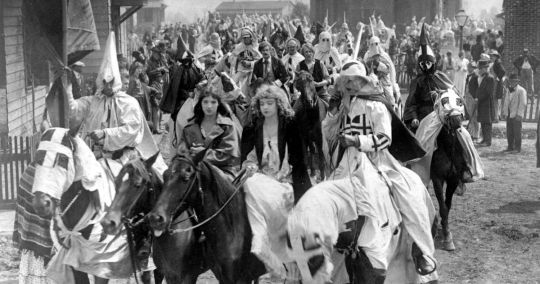
The Birth of a Nation (1915)
We are starting off rough with possibly the most controversial film of all time. There were protests against this film from both black and white cinema goers even at the time (according to the AFI blurb) and it is evident that the director, D.W. Griffith, overstepped some boundaries as he made the apology piece Intolerance the very next year to win back general audiences. The film depicts Abraham Lincoln positively, which was unexpected to me, and former slaves as animalistic and uncontrolled. The Klu Klux Klan comes along and “heroically” controls the former slaves and depicts the reformation as a time in which white women were afraid to walk the street for fear of attack by former slaves. The lack of support for this film by any black actors is apparent since almost all of offensive black men portrayed in the movie are white actors in black face. As difficult as it was for Black Americans to find work outside of farming and industrial labor in the early 1900s, you still couldn’t even pay them to be in this film. It is hard to gauge if many Americans agreed with the opinions reflected in this film at the time, but some people apparently thought that it was a mistake to free the slaves since black people needed to be controlled and why not get free labor for farm owners at the same time.
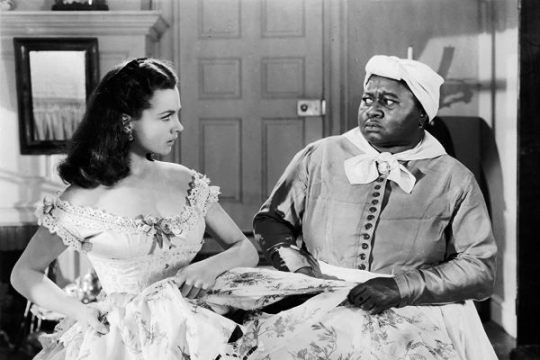
Gone With the Wind (1939)
This is a favorite movie in my family so I cringe slightly watching this film now knowing about about Hattie McDaniel’s Oscar and legacy. The role of Mammy was played by McDaniel and she won the Academy Award for Best Supporting Actress...but she had to get special permission to attend the ceremony since the awards were given out at a segregated hotel. She had to use a back entrance and was seated far in the back in an area that was roped off from the white guests. McDaniel was very good at her role since she had played a maid on over 70 occasions and was hassled by the NAACP to use her award as a platform to promote equal rights. I have little reference to what the world thought of the film, but the 13 Oscar nominations and this being the highest grossing film of all time when adjusting for inflation tells me audiences were OK with if not impressed by the portrayals. It seems that America was accepting of the “friendly and accepting” slave who was like a family friend who wasn’t equal but allowed to stay if they did a good job cleaning up around the house. This was not a very accurate portrayal of most slave-master relationships, which McDaniel admits, but she is quoted as saying “it is better to get $700 a week to play a maid then get $7 a week to be one.”
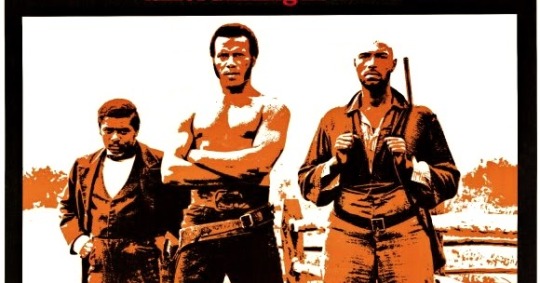
The Legend of N****r Charlie (1972)
During the 60s and 70s, there was a genre of films known as “blaxploitation” which capitalized on the idea that black characters were portrayed stupid thugs that were easily subdued by intelligent white men. This genre did the opposite and featured black heroes who overcame adversity with their power and intelligence, normally over a white adversary. This particular film portrays a slave taken from Africa who is falsely accused of murder and has to run from a racist white sheriff. He turns into a gunslinger and makes a posse of other black gunslingers and this group defeats the evil sheriff and escapes. This portrayal seems as likely as that of Mammy, but the very poor production value and terrible acting (it is pretty difficult to get through) meant no awards. Noting that the box office sales were high almost exclusively at theatres in predominantly black neighborhoods, America was split on the depiction of slaves. White people seemed to be happy with the housemaid while black people wanted a tough hero that rises up and gets vengeance on their oppressors.
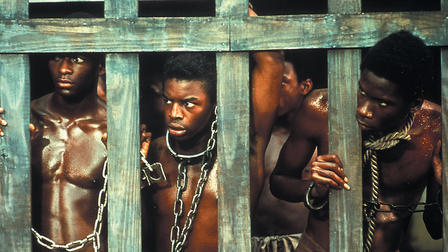
Roots (1977): 8 Part Mini-Series
I was unaware that this miniseries was shown over consecutive nights in January of 1977, but tens of millions of people watched all of it (that is 12 hours over 8 nights) and still talk of the impression it made. This movie showed Lavar Burton (you know, the guy from Reading Rainbow and the actor who played the blind guy on Star Trek) as a slave stolen from Africa who was shackled and beaten into a life of submission. This film portrayed slavery as an atrocity that planted seeds of hate and distrust that carried on through generations over hundreds of years. Judging by the ratings, this woke up a lot of Americans to the horror that was slave life. Portraying slaves as happy house maids or whistling old men with big smiles was no longer acceptable. The final episode of this mini-series remains the 3rd highest rated showing of all time according to the Nielson ratings. The series as a whole was nominated for an astounding 32 Emmy Awards and won 9 of them. The low win count was due to multiple actors from the series competing in every acting category. After Vietnam and going into the Cold War, America wanted gritty realism and this seems like exactly that.
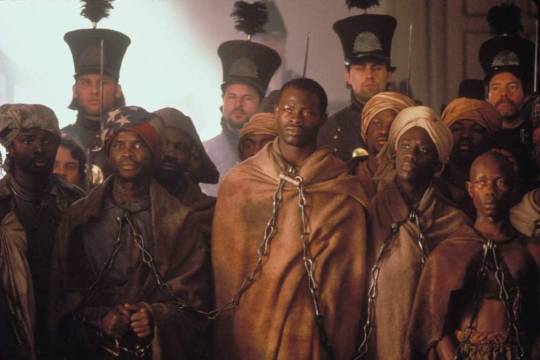
Amistad (1997)
I find this to be idea of slavery that I most relate to as realistic. It stars Djimon Hounsou as a slave that leads a revolt against the slave traders on the ship Amistad in which the entire white crew was slaughtered and the offending slaves were brought to American courts to stand trial for murder. This was based on a true account and directed by Steven Spielberg. One might note that the top billed actors are actually Matthew McConaughey, Morgan Freeman, and Anthony Hopkins, but Hounsou absolutely stole the show. I hate courtroom drama in general, but the testimony of this slave was riveting. According to historian accounts, there was a point during this infamous crossing in which it was decided there was not enough food for all the slaves so a couple of dozen humans were tied to a rock and thrown overboard. It has been over 20 years and that still sticks with me. I wouldn’t expect this to be done to cattle, and the scene of the slaves screaming as they know the rock will pull them down and they have seconds to live still haunts me. It encouraged me to look up accounts of slaves and others who saw first hand how bad things got.
-------------------------------------------------------------------------------------------------------
I took a an anthropology class in the early 2000s and I remember learning about evidence that proved the horrific treatment of some slaves. It is true that some slaves were allowed to live in the house and treated like family. It is true that some slave owners paid their slaves a small amount or even freed them in their will. However, there are also many children of mixed heritage that prove the amount of rape that occurred. There are also bones in shallow graves in back of some of these old plantations that show evidence of multiple breaks, amputations, mangled limbs, and broken backs that have no sign of treatment but the wear and tear of continued use. These people were worked and beaten to death. If that is what happened, then I don’t want it glossed over with Hollywood scriptwriting.
But I said I would be objective so I will stop there. I can feel myself getting angry and opinionated as I write. Learning about history and enjoying a story on film for entertainment can be separate things. Deep breaths.
There are many, many other movies that portray slavery including The Color Purple, Song of the South, Django Unchained, 12 Years a Slave, and Glory. I am not as familiar with these films as the ones listed above, in fact I still haven’t seen 12 Years a Slave. What I wanted to demonstrate was that films will often depict social issues in a way that is consumable by the masses, and changes in the way things are depicted can indicate a change in public opinion. From what I see in film, the American population once thought of former slaves as a problem that needed to be solved and bringing back slavery could solve that issue. It transformed to a feeling that maybe slavery wasn’t all bad and some slave owners were pretty good to their slaves. Black Americans responded with a genre that said that maybe slaves were tough and amazing which scared people into trying to control them. After the Vietnam War and Watergate, Americans wanted the gritty truth and films began portraying slavery as horrific and scarring to the point of affecting generations with hate. Todays movies seem to recognize the atrocities and to almost look at these actions the same way we look at genocides: how could we let this happen? The students that I work with are now assigned movies and readings that highlight genocide and enslavement, which means to me that we are not in denial of how bad it was and instead looking into keeping it from ever happening again. Perhaps there will be a different viewpoint in 20 years. Until then, I will keep watching movies to get an idea of what the public thinks.
#films as history#slavery#slavery in film#Amistad#Roots#Gone with the Wind#the birth of a nation#popular culture#introvert#introverts#american history
23 notes
·
View notes